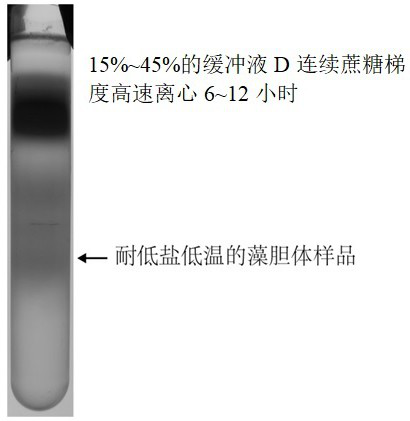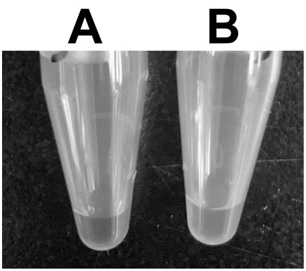Preparation method of low-temperature-resistant and low-salt cyanobacteria phycobilisosome sample
A low-temperature-resistant, cyanobacterial algae technology is applied in the field of preparation of cyanobacterial phycobilisome samples, which can solve the problem of poor contrast of protein samples, and it is difficult to study the interaction between phycobilisomes and photosystem complexes, as well as the mechanism and structural resolution of energy transfer. rate limits etc.
- Summary
- Abstract
- Description
- Claims
- Application Information
AI Technical Summary
Problems solved by technology
Method used
Image
Examples
Embodiment 1
[0024] Example 1. Preparation of low-salt and low-temperature cyanobacterial phycobilisome samples
[0025] 1. Prepare buffer A (0.9 M sodium phosphate buffer pH 8.0, 1 liter contains 300.41 g Na 2 HPO 4 •12H 2 O, 9.55 g NaH 2 PO 4 • 2H 2 O and 10 mM EDTA) and buffer B (0.75 M potassium phosphate buffer pH 8.0, 1 liter contains 160.9 g K 2 HPO 4 , 6.12 g KH 2 PO 4 Buffer A and 10 mM EDTA), buffer A and buffer B are the storage solutions of buffer C, and buffer A and buffer B are mixed in equal volumes to obtain buffer C;
[0026]2. Add 0.0075% (w / v, g / mL) 1,5-glutaraldehyde (GA) and 10 nM BS3 to buffer C to make buffer D;
[0027] 3. Sterilize the solid sucrose, and use buffer D to prepare 15% (w / v, g / mL) and 45% (w / v, g / mL) sucrose solutions;
[0028] 4. Take 1 g of thylakoid membrane-free cyanobacteria cinerea Gloeobacter violaceus PCC 7421, ground and crushed in liquid nitrogen, and the following steps should be protected from light as much as possible;
[002...
Embodiment 2
[0033] Example 2. Preparation of low-salt and low-temperature cyanobacterial phycobilisome samples
[0034] The preparation steps are the same as those in Example 1, except that 0.015% (w / v) 1,5-glutaraldehyde (GA) and 500 nM BS3 cross-linking agents were added in step 2, and a complete low-temperature and low-salt-resistant cross-linking agent was also obtained. phycobilisome samples.
PUM
 Login to View More
Login to View More Abstract
Description
Claims
Application Information
 Login to View More
Login to View More - R&D
- Intellectual Property
- Life Sciences
- Materials
- Tech Scout
- Unparalleled Data Quality
- Higher Quality Content
- 60% Fewer Hallucinations
Browse by: Latest US Patents, China's latest patents, Technical Efficacy Thesaurus, Application Domain, Technology Topic, Popular Technical Reports.
© 2025 PatSnap. All rights reserved.Legal|Privacy policy|Modern Slavery Act Transparency Statement|Sitemap|About US| Contact US: help@patsnap.com



